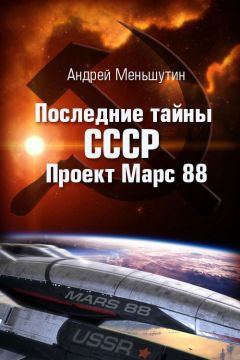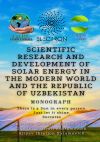Текст книги "Последние тайны СССР – Проект Марс 88"

Автор книги: Андрей Меньшутин
Жанр: Космическая фантастика, Фантастика
Возрастные ограничения: +12
сообщить о неприемлемом содержимом
Текущая страница: 1 (всего у книги 7 страниц) [доступный отрывок для чтения: 2 страниц]
Андрей Меньшутин
Последние тайны СССР – Проект Марс 88
English
Much has been in the USSR polygons: Plesetsk and Sary-Shagan, Baikonur and Kapustin Yar Semipalatinsk and Novaya Zemlya. All and will not list. By and large – the whole vast country under the name of the Soviet Union was one single – Polygon.
Polygon – it is almost always developing and testing new things… to move forward.
To all those who were on the Polygon
Instead of preface…
There were a lot of secrets in the USSR, even the things which did not require any secrecy at first glance…
As the country collapsed, many of such secrets were revealed to those from whom they were concealed. The newest technologies, whose development took decades and tens of billions of dollars, and sometimes the most precious thing – human lives, were sometimes sold at a million or two, and sometimes given out practically for free.
Anyway, there were more secrets than one could sell, steal or learn for free. There were some mysteries which died along with the huge country.
One of them is the project “MS – 88”
There were just 9 people who knew about the real aim of this project in the whole of the USSR with the population of almost 280 million. General Secretary of CPSU Central Committee Andropov, minister of defense, general designer and… And of all the mighty General Secretaries, Andropov was the last one who knew about the project and, the main thing, understood its essence. Chernenko had other troubles – why should a gravely ill person be bothered about some deeply scientific things? Moreover, he died very quickly – maybe there was just no time to inform him.
The extremely talkative Gorbachev was not informed about it due to his excessive talkativeness. Moreover, the project was practically completed – it was just a matter of waiting for the results…
After that, there was nobody to inform – the minister of defense died, too. The general designer reported directly to him and preferred not to skip over the authority of his boss, even though he was deceased…
-1-
In the huge and mysterious taiga of Arkhangelsk, the most active and just as secret cosmodrome of the Soviet Union covered several thousand square kilometers. The nature itself protected such a large territory of the secret object.
Swamps, small rivers and lakes side by side with impassable wilderness. Nobody took care of the forest, and thousands of trees that had their day fell down and broke, creating natural barriers between new trees that our ancestors used about 700 years ago or maybe even earlier.
The taiga stretched on all sides beyond the horizon and really reminded of an endless green ocean. Just a few railroad lines bifurcated from the Northern track Moscow – Arkhangelsk and disappeared in this green silence.
The quiet was disturbed several times a week by powerful rolling boom of starting rockets. But practically nobody heard this sound except for the nearest military units and the launching crew. Small and sparse villages were located far away, and the northern taiga itself absorbed almost any sound better than any modern soundproofing…
The only thing the taiga could not absorb was light. In the absolute silence, a small dazzling spot would suddenly flash above the green horizon. First it seemed a kind of a toy balloon or a sparkle on a New Year tree that seemed to appear from nowhere in the wild taiga.
But the balloon was going higher and higher and growing brighter a brighter, like the metallic light of stars in the black space that suddenly drew much closer.
The northern sky is special, and nights are really white here in the middle of the summer. It is light like on a hot midday in June, but there is no sun in the sky. The star flying up seemed dazzling bright even against such a light background. Sometimes almost half of the sky started to shine due to particular weather conditions of the day or night of another launch, and it seemed that not one but dozens of rockets were starting off at the same time…
The star was going higher and higher and the sky gradually stopped shining, becoming a regular summer sky. And below it, the huge green sea remained just as thoughtful and silent.
Surely, things did not always look so beautiful; sometimes stars flew back to their native space practically imperceptible. For almost 20 years, the taiga cosmodrome was the most active in that, somewhat different, world. Almost 1 500 rocket launches – 40 % of all the world’s space starts.
And all that happened far from the civilization, in the harsh conditions of the almost extreme North.
And preparation of a rocket for the start is nothing like the morning warm-up and cleaning the car of the snow before driving to work, even when you fling out at –20 °C without outdoor clothes and your car would not open, and even if it does after several attempts, it would not start…It’s cold and nasty, you are short of time and you have to run for a spare battery or get assistance from those whose car started or try to push it… and how can you push a car that weighs 300 tons and is 50 meters long?
In winter there are no mosquitoes or even more disgusting gnat. And in the summer the wood is very beautiful and there are a lot of aspen mushrooms with red caps– but it’s difficult to pick them because of those that are absent in winter…
And it's not everywhere that you can pick these mushrooms.
Looking in the black silent space that surrounded the spaceship, with bright white spots of an endless multitude of stars, it was for some reason these red mushroom caps which no one needed that Andrey recollected.
Andrey was an onboard engineer of the manned spaceship of М-88 project and at the same time – a USSR KGB officer. He was not included in the crew because the omnipotent Committee was looking for CIS or MI-6 spies even in the space or because he had to shoot down, for example, the crew captain under certain circumstances. There was even no gun or any weapon on the spaceship at all.
It was just a personal wish of General Secretary… In the course of one of rare meetings with the project Coordinator he suddenly said: servicemen, scientists, doctors – all of them were in space, we sometimes even take foreigners there! And we have never included a single KGB officer in the crew!
The Coordinator was a bit surprised, but answered: Yuri Vladimirovich, that’s an interesting thought, but it would be better if he had some other profession besides being an officer. The crew is almost complete – there is a place for an onboard engineer, and considering the peculiarities of the spaceship – we need a specialist on compact nuclear power systems. Do you have someone of this kind in the Committee?
In the Committee of that time there were specialists in practically any sphere, especially in promising trends, let alone those connected with the atom.
They found Andrey… He graduated from a minor institute in Moscow where best graduates were distributed to closed military laboratories, design offices and KGB…
In general, people were not sent to the Committee, the Committee kindly invited them to work. One could refuse with no bad consequences to follow. Why should a person be compelled if he does not want to? Compulsory labor is not always efficient.
The nuclear power facility of the spaceship was surprisingly efficient, and the main thing, it was compact. It took almost 25 years to create it. The question of reduction of nuclear facilities in size and weight appeared from the moment when the first atomic bombs appeared and was in many ways solved by the beginning of 80s. Even real nuclear briefcases appeared, but not those carried after different Heads and Presidents…
Many nuclear things, big and small, were created for military reasons, and there even was no desire to use all that stuff for the intended purposes.
People became a little cleverer, a little more polite and civilized, and understood that hitting themselves with nuclear clubs was not right or humane.
They decided to use something from this nuclear arsenal for peaceful purposes.
There was no sense in constructing large, labor-consuming and expensive nuclear power stations, considering the huge territory of the USSR and the peculiarities of its climate. There were hundreds of thousands of rivers, but the construction of hydro-electric power stations is not that cheap…
Then they remembered about compact or portable low power nuclear devices. A project was conceived to create small, reliable, and the main thing – one hundred times cheaper nuclear power stations. It was planned to build such a station in practically each of the remote regions…After all, the country occupied 1/6 of the land; but the project was suspended…
The question of portability, weight and, the main thing, the weight of fuel was the most acute in space industry. It was the trend with the highest priority for the Soviet Union. The majority of the most talented scientists worked for the space. Solar batteries were cumbersome and produced little electricity, the first compact nuclear power facilities were developed and used for the satellites – for the only purpose of providing energy to the devices…
The work on the nuclear propulsion engine for rockets was finished back in 1981. The trial runs were mainly carried out on the same launch site where military atomic shells and bombs were tested – near Semipalatinsk.
The project was successful and almost complete, but… it was closed. There were a lot of reasons for that, but the main thing was connected with the start of the rocket from earth cosmodromes: due to a great amount of radiation emitted, a new launch pad or desk would have to be built for each new launch.
And problems with protection of the rocket’s living module seemed practically unresolvable back then…
The designer of MS 88 found a little different way to solve these problems.
The nuclear propulsion engine started as far from the Earth as possible, being the second or third stage engine of the spaceship. And it did not work directly, so its radiation background was just one and a half or two times higher than natural values.
Protection of the crew from such relatively low level of radiation was also simplified and was solved in three years. It took a couple more years for final breaking-in, fine tuning and trial. So in six years after closure of the first project, the second one was successfully completed. It is true that it had a lot of principal differences, but it was the same in essence.
The problem of energy and heat supply to the spaceship on the whole was successfully resolved. And the main thing, now there was an opportunity to use practically the whole volume and weight of the rocket for more important tasks…
Andrey was the KGB supervisor of this design office. First of all he was responsible for the project secrecy, and a little less for its successful final result.
The result was dimly shining behind the 50 cm partition of the energy compartment, transforming the energy of arms-grade plutonium into quite peaceful electrojet one, which pushed the spaceship closer and closer to Mars.
Andrey’s shift always started with examination of the propulsion component monitoring unit and a visual check-up via a distance video camera. He did this even though he did not need to control or even provide maintenance for anything there.
The device was reliable and compact like a Kalashnikov gun, the famous AK-47.
The fuel could last for 5 years of continuous work, and recharging was available in case of need. There were only three propulsion engines, and now just one of them was working. Surely, all the three could be started at once, but it was to be done only when the spaceship started from the Mars surface on the way back…
Nuclear briefcases were so successful and compact that 8 of them were crammed in the rocket! Each of them weighed about 100 kg and had four massive handles… but it was not important in the space, and even the handles were not necessary.
Three of them were for the replacement of the main propulsion engines in case of need, and three were a little smaller and had to supply heat and energy to a small living module installed on Mars. One would be more than enough; the other two were just a reserve.
Andrey examined all these facilities every shift as well. All of them were located and secured in the space between the double rocket bodies. He had to check the fixtures as it would be bad if nuclear facilities, even though compact ones, hung loose behind the partition in zero-gravity…
Well, and the two remaining briefcases were the smallest and were to be used in the extreme variant as emergency sources of heat and electricity. All the variants of briefcases had additional modules and could produce practically any kind of energy needed for subsistence of the crew both during the flight and while on Mars.
These modules had the largest size and were much more complicated than the mobile nuclear facilities. And they took more time, efforts and money to develop than the briefcases themselves. An independent scientific and research institute worked on each module.
The rocket itself was the product of work of tens of institutes which did not know the ultimate goal or the reason why all that was done. Some of them suspected it was the newest tank, others thought it was a plane, while some others considered it to be a submarine! By the way, the design of the spaceship really reminded of the newest nuclear submarine…
It had a double body. However, unlike real submarines, both bodies were solid; it just did not have a protruding cabin, torpedo launchers or bird roosts. It was harder with the institutes which had been working with space projects for a long time and with fellows from Plesetsk cosmodrome itself…
Andrey flew to the cosmodrome before all the crew members and was responsible for secrecy of preparation of this rocket for launch.
In reality, it was not that difficult. The spaceship practically did not differ from an ordinary carrier rocket of the series “Molnia – М” from the outside…
The rockets of this type were launched from the military cosmodrome at least 10 times a year. However, it was almost 5 meters longer than a standard 8К78M, the diameter was almost the same – 10 meters, it weighed 25 tons less and contained a suspiciously small amount of fuel! There was an official version for the majority of people – it’s an almost standard rocket, with experimental, more economical engines.
In general, even this disguise was not necessary. Missile officers and civil specialists worked for a long time and saw the launches of hundreds of rockets of a dozen different types. Space romanticism and interest were replaced by usual everyday work in hard northern conditions. We have launched many things – this one will be no exception.
Andrey was distracted from earthly recollections and monitoring unit by a trunk into the adjoining section which opened almost noiselessly.
He did not even turn to see who opened it. It surely was not an extraterrestrial or any other humanoid loafing about in space. Even if it was an extraterrestrial, it would be called Sveta anyway…
Andrey turned around and took a look. Svetlana has almost flown half of his 15-meter service compartment. Different thoughts came to his head: what if Svetka had a summer dress on or a blouse with a short skirt? She would probably try to adjust a part of clothes that slipped up improperly high and instead of that would funnily tumble over with even more erotic consequences…
But she was wearing casual light overalls which suited her just as well as any other clothes. Sveta has already flown practically close to Andrey and looked at him smiling slightly and a little too attentively… as if she knew what he was thinking about.
In endless space, with its loneliness, cosmic wind and zero-gravity, all the feelings, sensations and thoughts were perceived somewhat differently…
And Svetka with her grayish blue eyes, short fair braids and dimples in her cheeks whom he has known for a long time, seemed familiar and absolutely different at the same time… in general, not like she was on Earth.
Sveta looked into Andrey’s eyes even more attentively and smiled without a shade of suspicion in her eyes. And how wrong she was! He took her hand carefully and kissed on the right dimple. Svetka laughed and said: A space maniac… so that’s the way you say hello now?
Andrey looked at the upper zip fastener of Svetka’s overalls and followed it to the place it began, on her very attractive waist: Hello, Svetik.
Hello, Andrey… Let’s go to look at the harvest, or you will surely do something to my overalls…
Andrey asked himself jokingly whether the whole crew except for him became paranormalists. He knew, of course, that his look at the zip was not left unnoticed, and that was the reason why he looked…
Sveta surely understood all that perfectly, so she smiled coquettishly and slunk like a fish towards the opened door, her favorite greenest compartment. Andrey swam after her in accordance with the instructions, closing the air-tight door to the service compartment after himself.
Svetik, just like she had to do in accordance with her position, but most probably – her calling, was already flying between three-meter shelves stuffed with hydroponic farm stuff. Everything that could be eaten grew here, and there were a lot of vegetables.
Fruit grew for a long time and did so very unwillingly.
The collection of seeds of different plants, practically from the whole world, started to be gathered in the USSR before the Second World War. However, sometimes politicians did not like plant breeders, so this science did not enjoy great support. But sooner or later even politicians understood that it would be hard to move ahead without breeding. And there are a lot of sciolists and just impostors everywhere, and breeding as a science is not to blame.
So you could find practically everything in the biological compartment, even something that probably did not grow on the Earth itself. A part of plants was selected just to produce more familiar oxygen that the one present in the self-contained system of crew life support. However, the majority of these were plain boring containers with all kinds of algae.
A few ordinary Russian birches were especially great, it’s a pity they were small. There were 3 or 4 oaks and about five green conifers… So crew members rarely called this compartment a biological one.
Somebody called it a forest, somebody a winter garden, a jungle, or jokingly a vegetable garden. All crew members often gathered here and started to fool about – play hide-and-seek or shout: Hello! I am lost! Sergey, the crew commander, pretended to be a mushroom gatherer and looked for mushrooms, flying between the shelves… and he found them!
Surely, they did not grow on partitions or the conditional floor. These were ordinary mushrooms from the Earth that were very similar to pleurotus that earth dwellers grew in their kitchens and balconies. And you had to look for them because Svetka often took them to different shelves – mushrooms grew faster than anything else and were eaten just as quickly… You had to eat anything that grew, and mushrooms alone were not sufficient!
-2-
By the start of the MS 88 project, the ordinary “Molnia” had been traveling to space for almost thirty years.
It was called so because it main task was to put “Molnia” communication satellites into orbit.
The rocket turned out to be reliable and even lucky. It was used to launch automatic interplanetary stations to the Moon and Venus, and also Mars which was much farther.
“Luna – 9”, the first space vehicle that made a non-destructive landing on the surface of the Earth’s satellite, was also delivered there with the help of the “Molnia” carrier rocket, but with an “M” index meaning “modernized”.
8К78М delivered five automatic interplanetary stations to Venus alone. The carrier had an almost 100 % reliability ratio, that’s why it was taken as a basis for the project of a manned flight to Mars.
By the time the project was at its final stage, it just had the recognizable appearance left from the usual “Molnia-M”. Inside, the rocket was more similar to “Mir” space station, and only two stages were left of the standard four.
Правообладателям!
Данное произведение размещено по согласованию с ООО "ЛитРес" (20% исходного текста). Если размещение книги нарушает чьи-либо права, то сообщите об этом.Читателям!
Оплатили, но не знаете что делать дальше?








































